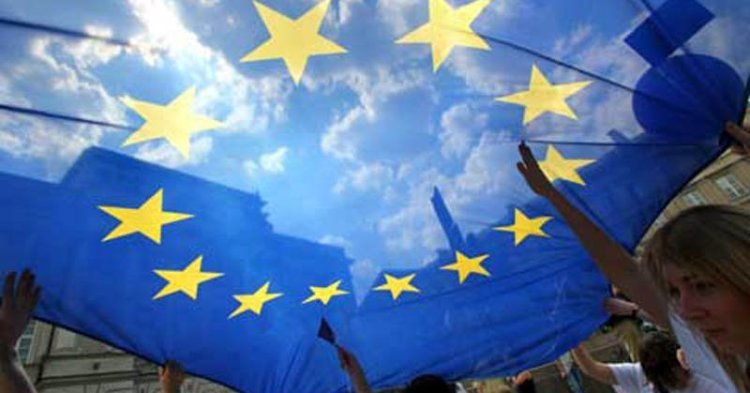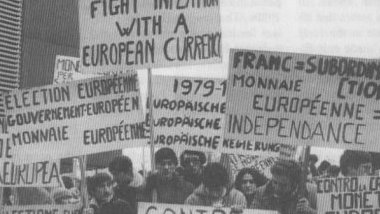I have been active in Spanish and European politics for over 30 years. Back in 1998-1999, when I was the nominee of the Spanish Worker’s Socialist Party for prime minister, I said that I was in favour of a Federal Spain in a Federal Europe. Well, it did not go down too well among some Party insiders, including the former prime minister Felipe Gonzalez, who told me that federalism was disliked in both European Union (EU) and Spain. He may have been right at the time.
However, three lustra later, the situation is quite different, even if we are still far from an ideal Federal Europe. In Brussels, as Andrew Duff, the former UEF president, has been saying, the “F-Word” is back in town. The flaws of the European Monetary Union, made apparent by the financial and economic crisis, and the need to revamp economic policymaking and the necessary democratic backing in the EU allowed federalism at least to be debated again. As for my country, tensions in Catalonia and to a lesser extent in the Basque Region have led to the discussion in political circles on federalism as the middle way between independence and the current status quo.
If we recall the Schuman Declaration of 9th May 1950, it is clear that the final goal was to arrive at the establishment of the European federation through gradual steps, like the setting up of the Coal and Steel Community.
Almost 65 years later, it is safe to say that despite the impressive progress made by the EU in maintaining peace in the Old Place and launching decades of economic prosperity – an achievement in danger of becoming a distant memory in the context of the continuing crisis – the integration process has fallen short of a full political federation.
This reality poses a number of questions. First of all, what do we mean by Federal Europe? Which are the key federal elements that are missing in the current EU framework? Is the EU already a Federation? Is the federal method the only way to achieve integration? Is European Federalism the most desirable approach to European integration? Lastly and perhaps most importantly: is a European Federation a feasible project? Are all countries in favour of abiding to the original goal as stated by Robert Schuman more than six decades ago?
1) What do we mean by Federal Europe? Is the EU already a federation?
There is a historical link between federalism and democracy, as it was perfectly shown by the creation of the United States of America. Most federations have been born as a consequence of a voluntary, citizen-based, social contract. The federal pact has been an instrument to set common sovereign powers among pre-existing political entities. Typically the competencies allocated to the central government in a federation included internal security, foreign affairs, military and taxes to finance the provision of these public goods. It is important to point out that in the present-day EU most of the public goods provided by the Union are financed not through federal taxes but by national contributions.
The key elements of the federal pact are mainly two, which are not necessarily found in a confederation. Firstly, citizens enjoy a basic and common set of rights, regardless of their state of origin, and they can be protected by a federal court. Secondly, citizens have the right to elect the federal authorities, which are not merely appointees or delegates from the federated units. Thus, a federation creates a unit of power, with direct legitimacy from the citizenry.
According to the elements pointed out above, some scholars consider that the EU is already a federal structure, or at least a quasi-federal one. There is a catalog of competencies, a parliament with legislative power elected by its citizens, and even a government if we take into account the precedent of Jean-Claude Juncker’s election. In addition, as is typical in many federal states, the EU has a citizen’s chamber (the European Parliament) and a state’s chamber (the EU council).
However, in order to properly speak about federalism, the EU would still need some fundamental elements: democratic legitimacy of all its institutions, something that reflects the existence of primary sovereignty, the capability to raise taxes in order to finance the exertion of its competencies, and the ability to act effectively in the international sphere.
At this moment the sovereignty still resides largely within the States. Besides, the existence of the unanimity rule in several fields such as the fiscal and social policies, the exclusive competency of the Council in foreign affairs and defense, the de facto intergovernmental Commission, and other elements call in question the existence of a true federation.
The European Union is an international innovation, combining intergovernmental/confederal and supranational/federal elements. At best, we can say that the EU is “a federation-in-progress”. Which are the key missing bits?: a) All EU legislation should be produced according to the co-decision method and by qualified majority voting, including foreign affairs and defense; b) Creation of a pan-European constituency; c) A supranational European Commission, elected by the European Parliament and the Council of the European Union and not by the member states; d) A European Parliament endowed of the right to perform legislation and introduce taxes at EU level (jointly with the EU Council); e) Limitation of the European Council to the role of collective chief of state; f) Creation of interpersonal solidarity mechanisms such as EU unemployment and elderly health insurance; g) A single voice in international affairs and security.
However, we must admit that a Federation treaty could hardly be agreed upon among all current states. Perhaps a minimum of pro-European countries could thus initiate a cooperation towards the desired European federation, with a federal core emerging within the current eurozone.
2) Can federalism only adopt the form of restrictive fiscal federalism or become a force for growth?
The sovereign debt crisis which most of the Eurozone countries have endured over the last years highlights the challenges the Economic and Monetary Union (EMU) should be able to cope with to be sustainable as a multilevel system of fiscal and economic governance. The main challenges are three: 1) how to enforce fiscal discipline; 2) how to dwindle the structural inequalities between rich and poor countries; 3) and how to prevent and tackle asymmetric shocks in an efficient manner. In practice, these are challenges that all federal, multilevel or fiscally decentralized systems face when allocating fiscal power to different levels of government, and likewise when attempting to find the middle ground between centralization and decentralisation.
At its inception, the design of the Economic and Monetary Union (EMU) had the makings of an extreme system of fiscal governance where the units retained the fiscal policy, including in full the taxing power, while spending was limited (within the limits of the Growth and Stability Pact of 3 per cent of GDP government deficit). The possibility of a bailout from the centre was excluded.
Regarding this first challenge, it was thought that fiscal discipline should come about as a result of market exposure. In addition to this and the spending limit, states were also supposed to follow the broad guidelines on economic policy issued by the EU Council every three years. And the markets were supposed to lend money at a rate depending on how fiscally healthy every state was.
However, the global financial crisis erupted in 2008 proved the institutional design of EMU lacked effectiveness and credibility. Up to that moment, the cost of funding for most Euro area economies had been similar, but with the crisis it became clear that markets did not consider that all Euro countries deserved comparable lending rates. As a result, the EU member states were forced to abandon the strict policy of no-bailouts in order to preserve the stability of the single currencies. The response was to create a temporary financial emergency mechanism and, later, a permanent one, the European Stability Mechanism, responsible for lending to Euro countries unable to finance themselves at reasonable market rates.
The second challenge is to what extent a currency area and a single market are capable of resisting inequalities and structural imbalances between rich and poor regions and creditor and debtor countries, and how to address them either through effective economic coordination or through fiscal tools such as a central spending power, some kind of transfer mechanism or the use of taxation at a central level as an automatic equalisation system.
Following from the above, how to prevent and counter these asymmetric shocks poses the third challenge.
In practice, the EU faces a crucial choice between two ideal models of fiscal integration: the “surveillance model”, where states continue to maintain all taxing powers and where the EU is just a mere enforcer of discipline; or the “classic fiscal federalism model”, where the EU acquires its own sphere of fiscal authority and thus its own fiscal tools for stabilization and where different fiscal functions are attributed to different levels of government. [2]
a) The “surveillance model” (also called ‘restrictive fiscal federalism’)
This could be considered the natural progression of the current status quo. In this model, Member States continue to retain full fiscal taxation powers and, consequently, they are the only ones that can raise revenues, while retaining the competence to conduct the general economic policy within the limits of the Maastricht Treaty and the new Treaty on Coordination, Stability and Governance. According to this model, EU’s role is the one of “discipline enforcer” which is in charge of policing the implementation of commitments such as discipline rules concerning fiscal and macroeconomic balances. The role of the EU is mainly corrective. In order to meet the challenge of enforcing fiscal discipline, the natural evolution of this model is to become ever stricter. As we have seen, now the 3 percent limit of government deficit is complemented by a 1 percent limit in structural government deficit, and the “European semester”, by which the EC is in charge of an ex-ante review of national budgets. Eventually, in a later phase, the Union may be empowered to achieve those objectives through specific policy reforms such as reforming the national pension systems, or even the tax system. Evolution towards further integration could take place through more detailed prescriptions and recommendations from the centre, and through the use of hard law within the surveillance procedures. On the plus side, the enforcement of more rigid fiscal and budget rules across the Euro area might ease the way towards mechanisms of debt mutualisation, such as the Eurobonds.
At a final stage, EU could routinely compel Euro area countries to allocate public resources in a certain way. This model, taken to its logical conclusion, would turn national administrations into simple implementers of policies that have been made at EU level. Evidently some countries will be reluctant to follow this path because tax and expenditure powers are traditionally seen as two of the last strongholds of national sovereignty and democratic decision-making.
b) The “classic fiscal federalism” model
On the other hand, the EMU could create an independent central fiscal authority in what would constitute the traditional fiscal federalism scenario. In this model, both member states and EU would have the competence to raise revenues to provide people with public goods. This scenario would also include some kind of “transfer union”. In general, the EU would have the necessary resources to address structural inequalities and prevent asymmetric shocks through fiscal instruments such as targeted spending or intergovernmental grants among others.
As an economic theory, fiscal federalism aims to find a normative framework for the assignment of functions and fiscal instruments to different levels of government. In fact, one of its classic tenets is that the central government should have the basic responsibility for macroeconomic stabilization, hence the centre should be able to raise its own revenues and impose its own taxes.
The question of who must be competent to impose taxes in a particular area is the core of a fiscally decentralized system. In theory, since the different levels of government are tasked with the provision of public goods, they will normally have revenue-raising power in order to be able to provide those goods. Moreover, it is widely accepted that the provision of public goods should comply with the subsidiarity principle. Thus, allowing EU to develop a larger fiscal space requires identifying the public good or goods to be provided; this may require redistributing the current system of competencies included in the Treaties.
In articulating these arrangements, it would be necessary to deal with several questions, including how to reconcile the new fiscal system within the Euro area with the wider membership of the Union.
c) Evaluation of the two models
Either the surveillance model or the classical federalist model are federalist in essence, since it empowers the central authority in the field of macroeconomic and fiscal policy in order to maintain financial stability and limit inequalities and the impact of asymmetric shocks. The main difference is that in the surveillance model the emphasis is in limiting with binding rules the fiscal (and eventually the social) policy space of member states, whereas in the classical federalist model the centre is given the power to tax and spend in order to promote growth and economic convergence, hence the emphasis is on what can be done instead of what cannot be done.
In other words, the two models are suited for a particular anti-crisis economic policy. Restrictive federalism is better suited for aiming at the achievement of budgetary balance as the way-out of a financial and economic crisis. Classical federalism is better suited for developing a countercyclical economic policy from the centre, backed by EU level tax revenues and bonds.
In the end the second model may protect national autonomy more effectively by guaranteeing member states the competence of deciding how to raise their revenues and how to allocate and spend them, and by limiting the level of detail at which surveillance from the centre can take place. In addition, democratic legitimacy is likely to suffer more with the surveillance model, since it gives a lot of power to the European Commission, a body whose only popularly elected member is the President; furthermore, he/she lacks the power to appoint the commissioners (each member state has the power to pick one). This model, if it were to evolve in the direction of further creation of binding rules in the field of national taxing and spending, will require, aside from likely Treaty changes, the participation of the European Parliament in order to provide full democratic power.
In addition, every subsequent step towards a deeper federation must be accompanied by a clear commitment of social justice and the convergence of social standards, including the establishment of an EU system of minimum wages. In principle, social federalism is compatible with both the surveillance and the classical federalist models, since the European Parliament can endorse a legislation mandating each member state to establish a minimum wage, and/or alternatively, establish an EU-wide minimum wage.
In the long term, the most likely scenario is a mix of restrictive and classical fiscal federalism. The balance in favour of the first or the second will be achieved if the economic stagnation continues and progressive political forces are able to channel popular demands in favour of effective pro-growth economic policies.
What is clear is that if we fail to have a proper fiscal federalism, openly agreed and democratically backed, we will have the surveillance model in an undercover fashion and enforced by unelected Commission officials. Countries should think carefully about which path is more approachable for them.
3) Is Federal Europe necessary/desirable? Are there other alternatives?
Up until now I have tried to clarify the issue of federalism. There are key elements of federalism missing in the present-day European Union, among them the persistence of national veto and the lack of a true common foreign and security policy.
This is why we European federalists continue to advocate for a Federal Europe, with full democratic legitimacy and able to act efficiently. After all, a European federation has always been the final aim of the European construction, ever since the Schuman Declaration.
However, is federalism the only perspective available to unite Europe?
The obvious alternative to federalism is inter-governmentalism, by which the European Council decides which areas are to be further integrated and how. This method has been intensely employed during the financial and economic crisis and has produced two new Treaties (the one establishing the European Financial Stability Facility and the Treaty on Governance, Stability and Coordination), the Banking Union and so forth.
The intergovernmental method basically places all the decision power in the hands of the 28 heads of state and government who sit at the European Council twice a year in formal meetings that last until the early hours of the following morning. This EU institution works by consensus. Its democratic legitimacy is indirect and it is not a legislative body. In contrast, we already have the Council of the EU which works ordinarily by Qualified Majority Voting, is in charge of co-legislating with the European Parliament and is already representing the national interests.
Now, it is clear that by intergovernmental agreements federal institutions and norms can be created. However, it is important to bear in mind that the democratic legitimacy of the decisions taken is lower, while reaching consensus is harder to achieve.
Looking outside Europe, a federation is the only way we have to overcome challenges that states alone would never be able to overcome in this global world.
Taking into account the new emerging economies with hundreds of millions of inhabitants, such as India, China, Brazil or Indonesia, Europe can only be a relevant international actor if it is united, with a single voice, establishing the EU as a key actor of this complex international society.
4) Conclusion: Is a Federal Europe feasible?
By now we have clarified that the EU is not yet a Federal union, that federalism can be of restrictive or expansionary nature, and that Federalism is not only desirable but necessary to have a more democratic and effective Europe able to play a key role in a globalized world. The best way forward to meet Europe’s great internal and external challenges is indeed the federal one.
Desirable as a Federal Europe may be, it is not clear that such a project is feasible.
European federation is certainly not the goal of the British Foreign Office, for one. In the 28-state EU it is a fact that there is not a Federal consensus. Many countries are not willing to either give more powers to the EU or change the decision-making rules thereby eliminating the national veto and restricted areas. Some think that further integration is not needed nor desirable – never mind through federalism or inter-governmentalism – while others even believe that the EU is a threat to either national identity or workers and ordinary citizens, as the surge of far right and left populists in the last European elections suggests.
Hence, the most logical conclusion is that this Federalist aim will be possible only in a context of differentiated integration, with the Eurozone developing as the Federal core of Europe.
A realistic integration policy must expect that not every step along the road to deeper integration will automatically be welcomed by every member state and its citizens. There are countries that have already decided they do not wish further integration within the monetary union, not to mention beyond. Therefore, future integration has to be approached more in terms of groups of countries. Until recently the prospect of differentiated integration was used as a threat, designed to put pressure on reluctant governments into agreeing to further integration. Nowadays, differentiation in integration must be seen as an opportunity. The new aim should be to give every member state the place that is willing and able to take up.
In sum, the new Europe that can be developed while the crisis nears its end should have at its core the Eurozone countries, which are may be willing to move ahead towards fiscal union and more coordinated social policies. Secondly, there are countries whose currency system is not the Euro and may remain so for a long time. And finally there are non-EU members, who have an interest in the EU market or other areas, but do not wish or are not able to become EU members. We are probably moving towards a Europe made of concentric circles. We can imagine Britain becoming and associate member, with its membership limited to participation within the internal market.
The aim in a short term is to restore the health of the monetary union at its core, so that it becomes again an attractive perspective. Under these circumstances, differentiation is simply a roundabout way of achieving a united European currency area, first step to establish an integrated fiscal and social union. Europe cannot be built without the working class, let alone against it. Hence federalism should be also an avenue for building a Social Europe. The federal method must be used to agree common social standards such as the minimum wage or to develop inter-citizen solidarity mechanisms. Restrictive fiscal federalism alone (the surveillance model) will not do.
To conclude, in today’s globalised world, where emerging nations such as India, China, Brazil and of course Turkey are getting ready to shape the political, economic and social destinies of our planet alongside the USA, the nations of Europe, which are too small by comparison, can only safeguard their prosperity and their social achievements by joining forces and standing together on all the key issues. This requires, sooner or later, a new step towards a federal union.
References
Hinarejos, Alicia. 2013. “Fiscal Federalism in the European Union: Evolution and Future Choices for the EMU”, originally published in Common Market Law Review Vol. 50 (6), 1621: https://www.kluwerlawonline.com/abstract.php?area=Journals&id=COLA2013161
Pisani-Ferry. Jean. 2010. “Europe´s Federalism Debate Revived”, Project Syndicate: https://www.project-syndicate.org/commentary/europe-s-federalism-debate-revived?barrier=accesspaylog
Thillaye, Renaud. 2013. “Coordination in place of integration? Economic governance in a non-federal EU”, WWWforEurope Working Paper no. 32: https://www.econstor.eu/handle/10419/125686
Tortola, Pier Domenico. 2014. “Integration theory and the future of the European Union”. Centro Studi sul Federalismo: http://www.csfederalismo.it/en/publications/research-papers/995-integration-theory-and-the-future-of-the-european-union-3







1. On 26 October 2021 at 15:11, by Christopher Packer Replying to: Is a Federal Europe Possible?
Replying to: Is a Federal Europe Possible?
I think there are two options
Confederation on a continental scale with five large medium federations
or
Ten large federations, but not encompassing the entire continent
http://www.peopleempoweringpolitics.co.uk/Governance.html
Follow the comments: |
|
